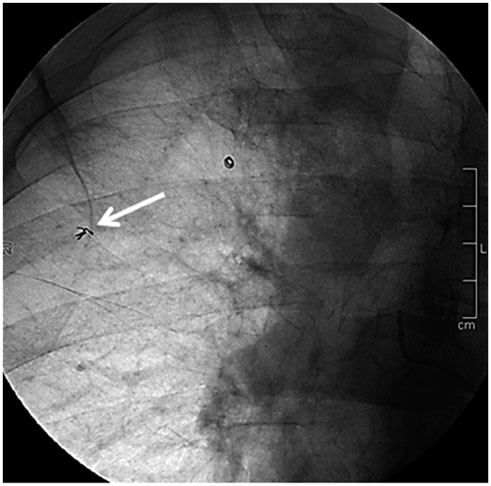Korean J Radiol.
2015 Jun;16(3):626-631. 10.3348/kjr.2015.16.3.626.
Intravascular Placement of Metallic Coils as Lung Tumor Markers for CyberKnife Stereotactic Radiation Therapy
- Affiliations
-
- 1Department of Radiology, Anadolu Medical Center, Kocaeli 41400, Turkey. kutlaykaraman@yahoo.com
- 2Department of Radiation Oncology, Anadolu Medical Center, Kocaeli 41400, Turkey.
- KMID: 2155533
- DOI: http://doi.org/10.3348/kjr.2015.16.3.626
Abstract
OBJECTIVE
To present our experience with placing endovascular coils in pulmonary arteries used as a fiducial marker for CyberKnife therapy and to describe the technical details and complications of the procedure.
MATERIALS AND METHODS
Between June 2005 and September 2013, 163 patients with primary or secondary lung malignancies, referred for fiducial placement for stereotactic radiosurgery, were retrospectively reviewed. Fourteen patients (9 men, 5 women; mean age, 70 years) with a history of pneumonectomy (n = 3), lobectomy (n = 3) or with severe cardiopulmonary co-morbidity (n = 8) underwent coil (fiducial marker) placement. Pushable or detachable platinum micro coils (n = 49) 2-3 mm in size were inserted through coaxial microcatheters into a small distal pulmonary artery in the vicinity of the tumor under biplane angiography/fluoroscopy guidance.
RESULTS
Forty nine coils with a median number of 3 coils per tumor were placed with a mean tumor-coil distance of 2.7 cm. Forty three (87.7%) of 49 coils were successfully used as fiducial markers. Two coils could not be used due to a larger tumor-coil distance (> 50 mm). Four coils were in an acceptable position but their non-coiling shape precluded tumor tracking for CyberKnife treatment. No major complications needing further medication other than nominal therapy, hospitalization more than one night or permanent adverse sequale were observed.
CONCLUSION
Endovascular placement of coil as a fiducial marker is safe and feasible during CyberKnife therapy, and might be an option for the patients in which percutaneous transthoracic fiducial placement might be risky.
Keyword
MeSH Terms
Figure
Reference
-
1. Adler JR Jr, Chang SD, Murphy MJ, Doty J, Geis P, Hancock SL. The Cyberknife: a frameless robotic system for radiosurgery. Stereotact Funct Neurosurg. 1997; 69(1-4 Pt 2):124–128.2. Chang SD, Murphy M, Geis P, Martin DP, Hancock SL, Doty JR, et al. Clinical experience with image-guided robotic radiosurgery (the Cyberknife) in the treatment of brain and spinal cord tumors. Neurol Med Chir (Tokyo). 1998; 38:780–783.3. Uematsu M, Shioda A, Tahara K, Fukui T, Yamamoto F, Tsumatori G, et al. Focal, high dose, and fractionated modified stereotactic radiation therapy for lung carcinoma patients: a preliminary experience. Cancer. 1998; 82:1062–1070.4. Whyte RI, Crownover R, Murphy MJ, Martin DP, Rice TW, DeCamp MM Jr, et al. Stereotactic radiosurgery for lung tumors: preliminary report of a phase I trial. Ann Thorac Surg. 2003; 75:1097–1101.5. Wulf J, Haedinger U, Oppitz U, Thiele W, Mueller G, Flentje M. Stereotactic radiotherapy for primary lung cancer and pulmonary metastases: a noninvasive treatment approach in medically inoperable patients. Int J Radiat Oncol Biol Phys. 2004; 60:186–196.6. Timmerman RD, Kavanagh BD, Cho LC, Papiez L, Xing L. Stereotactic body radiation therapy in multiple organ sites. J Clin Oncol. 2007; 25:947–952.7. Prévost JB, Nuyttens JJ, Hoogeman MS, Pöll JJ, van Dijk LC, Pattynama PM. Endovascular coils as lung tumour markers in real-time tumour tracking stereotactic radiotherapy: preliminary results. Eur Radiol. 2008; 18:1569–1576.8. Bhagat N, Fidelman N, Durack JC, Collins J, Gordon RL, LaBerge JM, et al. Complications associated with the percutaneous insertion of fiducial markers in the thorax. Cardiovasc Intervent Radiol. 2010; 33:1186–1191.9. Ginsberg RJ, Rubinstein LV. Randomized trial of lobectomy versus limited resection for T1 N0 non-small cell lung cancer. Lung Cancer Study Group. Ann Thorac Surg. 1995; 60:615–622. discussion 622-623.10. Imura M, Yamazaki K, Shirato H, Onimaru R, Fujino M, Shimizu S, et al. Insertion and fixation of fiducial markers for setup and tracking of lung tumors in radiotherapy. Int J Radiat Oncol Biol Phys. 2005; 63:1442–1447.11. Shirato H, Harada T, Harabayashi T, Hida K, Endo H, Kitamura K, et al. Feasibility of insertion/implantation of 2.0-mmdiameter gold internal fiducial markers for precise setup and real-time tumor tracking in radiotherapy. Int J Radiat Oncol Biol Phys. 2003; 56:240–247.12. Schroeder C, Hejal R, Linden PA. Coil spring fiducial markers placed safely using navigation bronchoscopy in inoperable patients allows accurate delivery of CyberKnife stereotactic radiosurgery. J Thorac Cardiovasc Surg. 2010; 140:1137–1142.13. Hong JC, Yu Y, Rao AK, Dieterich S, Maxim PG, Le QT, et al. High retention and safety of percutaneously implanted endovascular embolization coils as fiducial markers for image-guided stereotactic ablative radiotherapy of pulmonary tumors. Int J Radiat Oncol Biol Phys. 2011; 81:85–90.14. Mager JJ, Overtoom TT, Blauw H, Lammers JW, Westermann CJ. Embolotherapy of pulmonary arteriovenous malformations: long-term results in 112 patients. J Vasc Interv Radiol. 2004; 15:451–456.15. Pump KK. Distribution of bronchial arteries in the human lung. Chest. 1972; 62:447–451.
- Full Text Links
- Actions
-
Cited
- CITED
-
- Close
- Share
- Similar articles
-
- Role of Radiation Therapy for Non-small Cell Lung Cancer: Focused on Stereotactic Ablative Radiation Therapy in Stage I
- Cyberknife radiosurgery for inoperable recurred oral cancer
- A Case of Acute Injury in the Stomach and Duodenum after Cyberknife Therapy
- Radiation-Induced Pulmonary Injury after Cyberknife Radiosurgery for Lung Malignancy: CT Appearance
- Stereotactic Body Radiotherapy for Early Stage Lung Cancer




